E-signatures are an indispensable tool for businesses of all sizes.
The technology can streamline workflows, enhance security, and expedite the contract lifecycle.
Unfortunately, it’s difficult for a business to generate secure digital signatures on their own.
That’s where e-signature software comes into play — and there are a ton of options to choose from.
In this article, we’ll compare three of the biggest players in the digital signature market: DocuSign, Adobe Acrobat Sign, and Dropbox Sign.
We’ll take a closer look at their features, strengths, and potential drawbacks (as well as a few other competitors) so that you can make an informed decision when searching for an e-signing platform that aligns with your goals and budgets.
Let’s jump in.
Key takeaways
- DocuSign is considered the industry standard in e-signing and is known for its extensive integration options.
- Acrobat Sign features native PDF editing in addition to digital signature capture, as well as a deep integration with Adobe Reader.
Dropbox Sign provides e-signing with no transaction limits and integrates natively with Dropbox storage options.
DocuSign
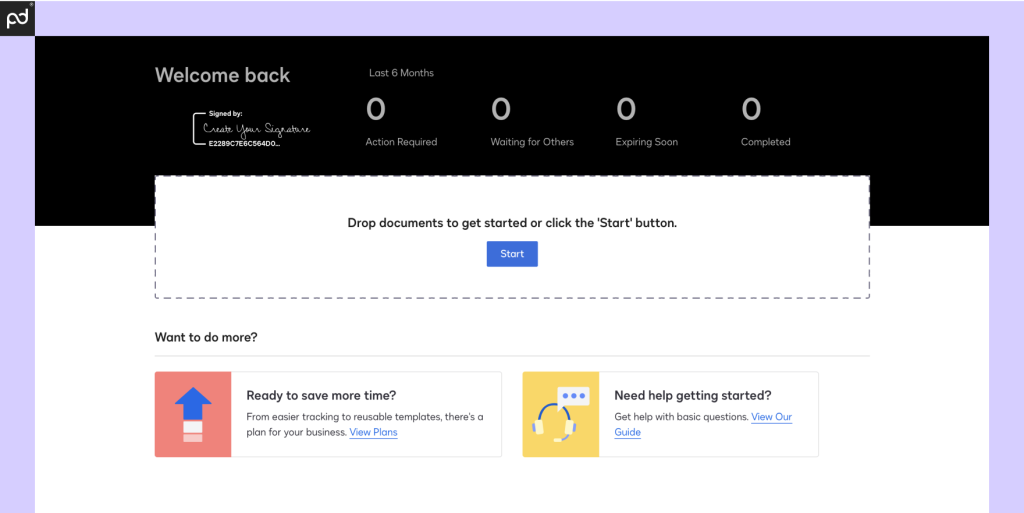
Pricing: Personal ($15); Standard ($45); Business Pro ($60). Enterprise pricing available. All pricing based on month-to-month commitment.
Ease of use: 9.0/10
Free trial: Yes; 30 days.
Support: Knowledge base; support tickets; additional support plans sold as separate packages.
Long considered to be the gold standard in e-signing solutions, DocuSign has been on the market for 20+ years and is known for its seamless signing processes.
The platform offers a range of features, spanning from workflow and template creation to scalable deployments for businesses of any size.
DocuSign’s secret to success lies in its integrations. Most of the app’s 600+ integrations are available to users of every tier, making it possible to connect DocuSign with most sales and CRM platforms.
Beyond that, API access is available for custom integrations, further increasing extensibility.
DocuSign is also one of the most scalable solutions in the market.
Its mix of support infrastructure and related document management solutions have allowed the company to extend far into the enterprise market.
Unfortunately for smaller businesses, the DocuSign experience is also restricted by company-imposed transaction limits.
These can be overcome by purchasing additional credits or licenses, further increasing the cost.
As a contender, DocuSign has the potential to be one of the most capable solutions in our comparison — if cost is no object.
Adobe Acrobat Sign
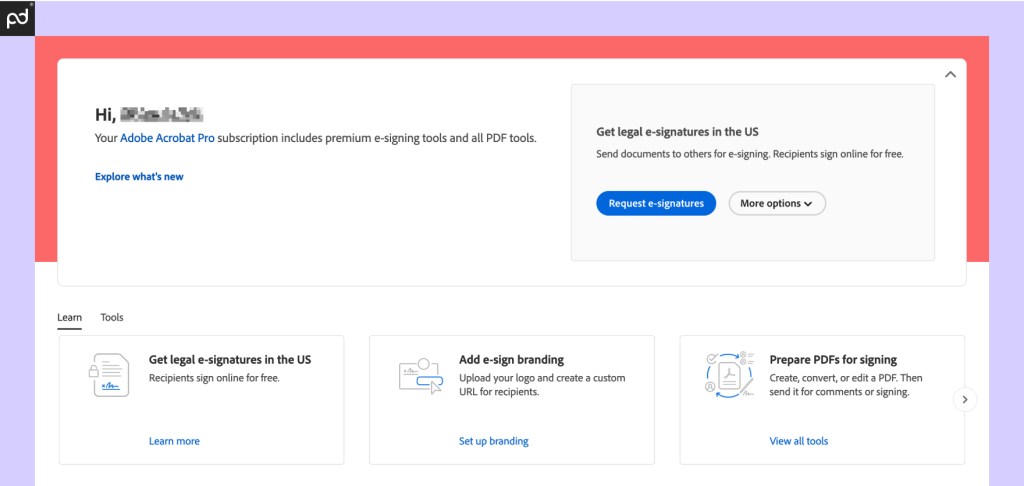
Pricing: Acrobat Standard ($23); Acrobat Pro ($30); Acrobat Standard for teams ($15); Acrobat Pro for teams ($24). Individual pricing based on monthly commitment. Team pricing requires annual commitment. Enterprise solutions available.
Ease of use: 8.2/10
Free trial: Yes; 30 days.
Support: Knowledge base; support tickets; live chat; additional support plans sold as separate packages.
Adobe Acrobat Sign, formerly known as EchoSign and Acrobat Sign, is a powerful e-signing provider with deep connections to the Adobe ecosystem.
The app offers seamless compatibility with other Adobe products, including Acrobat DC and Acrobat Reader, making it a natural choice for users already using other Adobe products.
However, Acrobat Sign’s key product differentiator is its ability to modify PDFs directly within its environment, a feature that distinguishes it from many other e-signature tools.
This is something you won’t see in DocuSign or Dropbox Sign, and it sets Acrobat Sign apart from the competition.
Aside from its editing capabilities, Acrobat Sign offers a similar experience to other digitals signing tools.
The platform is highly scalable and offers solutions for both individual users and enterprise organizations.
Similar to DocuSign (full comparison here), transaction limits are also imposed upon this product, preventing usage at scale without purchasing additional seats or credits.
Plus, Acrobat Sign’s extensive feature set and deep integration with Adobe products can lead to a steeper learning curve for new users.
Perhaps most critically is Acrobat Sign’s own admission that digital signatures captured on all plans short of its enterprise option don’t offer the same level of compliance as those captured at the enterprise level.
For smaller businesses and teams, this is something that bears heavy consideration.
Dropbox Sign (formerly HelloSign)
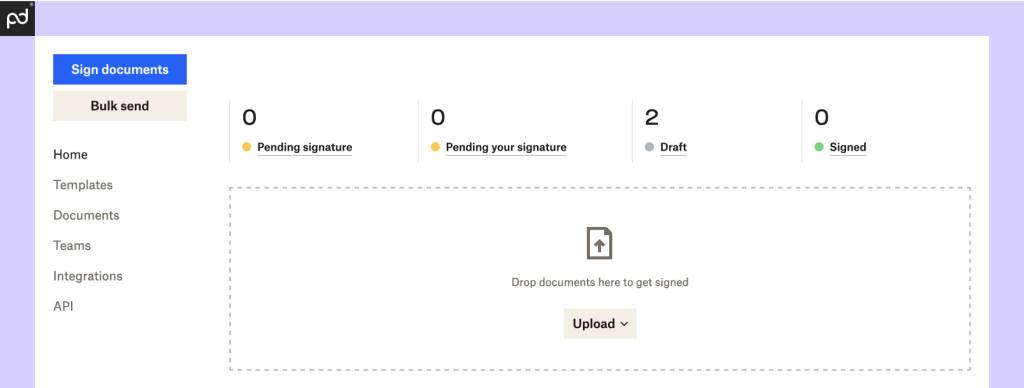
Pricing: Essentials ($20); Standard ($30). Enterprise pricing available. All pricing based on month-to-month commitment.
Ease of use: 9.3/10
Free trial: Yes; 30 days.
Support options: Email, knowledgebase. Paid support available for Standard plan with 5+ users and all Premium plans.
Dropbox Sign, formerly HelloSign, has carved a niche for itself as a user-friendly and cost-effective electronic signature solution.
Its intuitive interface and streamlined features make it an ideal choice for individuals, small businesses, and teams seeking a straightforward and efficient way to manage their signature workflows.
One of Dropbox Sign’s key strengths is its seamless integration with the Dropbox ecosystem.
This allows users to easily access, sign, and manage documents stored within their Dropbox accounts, creating a cohesive and efficient document management experience.
This can also create some confusion with pricing, because both Dropbox and Dropbox Sign offer e-signing options.
The key difference is that the Dropbox standalone plans are more focused on storage and lack the scalability of Dropbox Sign solutions.
Compared to DocuSign (full comparison here), Dropbox Sign falls short on features but tends to excel in simplicity and affordability.
The platform lacks the extensive integration options found in many competitors, and its customization options are limited.
However, Dropbox Sign is the only platform in this comparison that offers e-signing without transaction limits.
This alone makes it the obvious choice for users who are worried about sending limits or simply don’t want software usage caps.
Compared: HelloSign vs Acrobat Sign vs DocuSign
Want to see how these three e-signing platforms compare with one another?
While we’ll cover these differences in greater detail below, here’s a quick overview of the key features offered by each competitor.
| Plan Details | DocuSign | Dropbox Sign | Acrobat Sign |
|---|---|---|---|
| Core product | |||
| E-signature capture | ✓ | ✓ | ✓ |
| Real-time audit trail | ✓ | ✓ | ✓ |
| Notifications | ✓ | ✓ | ✓ |
| Language support | ✓ | ✓ | ✓ |
| Mobile app | ✓ | ✓ | ✓ |
| Reporting tools | ✓ | ✓ | ✓ |
| E-signing features | |||
| Signing order | ✓ | ✓ | ✓ |
| Send to multiple recipients | ✓ | ✓ | ✓ |
| Bulk send | ✓ | ✓ | ✓ |
| In-person signing | ✓ | ✓ | X |
| Collaboration tools | ✓ | ✓ | ✓ |
| Signer attachments | ✓ | ✓ | ✓ |
| Payment gateway | ✓ | X | ✓ |
| Document prep | |||
| Drag & drop fields (PDF) | ✓ | ✓ | ✓ |
| Create reusable templates | ✓ | 15 | ✓ |
| From-scratch document builder | X | X | X |
| Pre-built template library | X | X | X |
| Form creation | ✓ | X | ✓ |
| Custom branding | ✓ | X | ✓ |
| Integrations & API | |||
| Import & storage | ✓ | ✓ | ✓ |
| CRM | X | ✓ | ✓ |
| Productivity | ✓ | ✓ | ✓ |
| API | $ | X | X |
| Support | |||
| Email / ticketing support | ✓ | ✓ | ✓ |
| Chat support | X | $ | X |
| Knowledge base | ✓ | ✓ | ✓ |
| Phone | X | $ | ✓ |
| Premium support options | $ | $ | $ |
To balance features with cost, we compared the three most powerful off-the-shelf plans available for each company.
Those are:
- Business Pro ($40/month, annually) from DocuSign.
- Acrobat Pro for teams ($24/month, annually) from Adobe.
- Standard ($50/month, annually) from Dropbox Sign.
These plans represent the greatest level of functionality available for users prior to stepping into an enterprise or custom-built plan.
While we’ll discuss more about pricing, plan limitations, and transaction caps below, keep in mind that all the brands we’re comparing today offer solutions for every budget.
However, more cost effective plans may lack the features provided by more expensive solutions.
Requirements, workflows & pricing
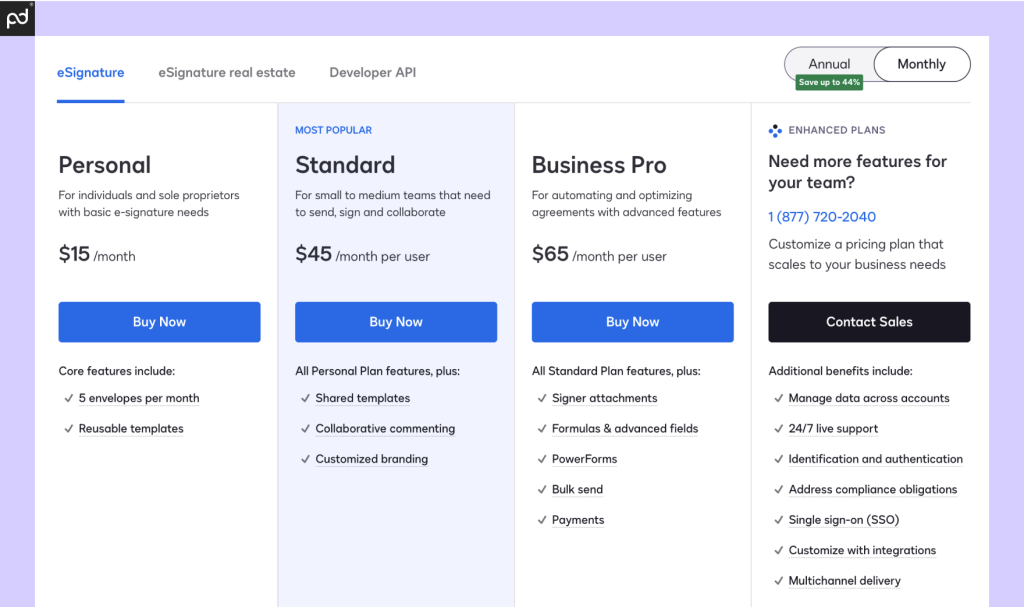
Efficient workflows and the ability to handle variable transaction volumes are key considerations for e-signature platforms.
DocuSign, Acrobat Sign, and Dropbox Sign each approach these challenges a little differently.
Of the three platforms, DocuSign offers the greatest number of automation features, allowing users to create complex signing processes with multiple signers, as well as sequential or parallel routing.
Higher-end plans also support conditional logic for signing fields, and approval workflows (both of which can also be found in PandaDoc).
Particularly at scale, DocuSign streamlines workflows by offering a high level of automation to the e-signing process.
The ability to create unlimited, reusable templates or to convert uploaded documents to web-based or embeddable forms further expedites the signing experience for both senders and recipients — especially recipients signing documents on mobile devices.
At the same time, DocuSign is limited in scope and offers a high-cost, restricted use case.
All DocuSign plans are restricted by an envelope limit.
Typically, this caps usage at 100 sends/year and about 10 sends/month. In order to increase usage, teams will need to purchase additional envelopes for an extra fee.
Particularly for power users, these costs can quickly add up.
The DocuSign experience is also limited in scope by design.
Unlike Acrobat Sign (discussed below), DocuSign offers very limited options for document editing and customization.
The platform is designed to attach to the end of the document workflow — meaning that DocuSign expects users to upload a finished document created elsewhere.
When corrections need to be made, documents must be taken offline, revised, re-uploaded, and prepared a second time.
That’s a major consideration when compared with platforms like PandaDoc, where built-in document editing allows for rapid corrections and updates — or even from-scratch document creation — without ever leaving the platform.
Acrobat Sign is the only platform in our comparison that offers onboard, native editing capabilities for uploaded documents.
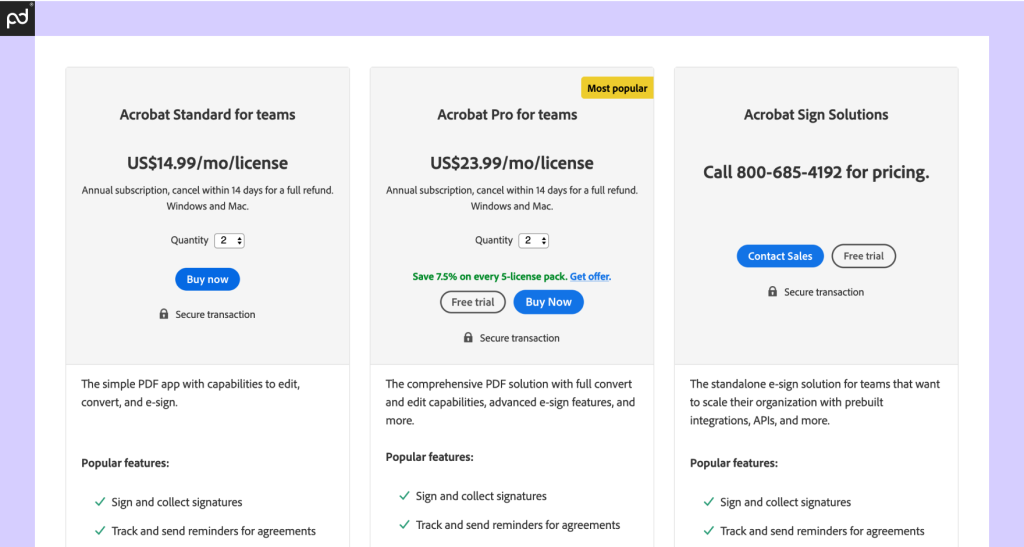
Users can upload PDF documents through Acrobat Sign and make broad, sweeping changes to those documents as part of the finalization process.
Text can be changed, images can be added, and entire documents can be heavily modified (although they can’t be created from scratch).
This eliminates the need to switch between platforms for document revisions, accelerating the workflow and saving valuable time.
Adobe’s trick for this is Acrobat Sign’s native integration with Acrobat Reader. Documents uploaded to Acrobat Sign are fully accessible to Reader, which allows for PDF editing on the fly.
It’s a feature unique to Adobe, and one that is rarely replicated outside of the platform. Only Foxit, makers of Foxit eSign and Foxit PDF Editor, really compares.
Outside of its native editing capabilities, Acrobat Sign offers a formidable selection of workflow features.
While these aren’t as extensive as what you’ll find in DocuSign, they’re sufficient to handle most business requirements, which allows the platform to strike a balance between power and ease of use.
However, Acrobat Sign also restricts its own functionality and use case with a combination of transaction limits and withheld security features.
Similar to DocuSign, Acrobat Sign users are limited by the number of transactions allowed on a given plan.
Generally, users are limited to 150 transactions per year, with Adobe providing 50 additional transactions compared with DocuSign’s offering.
The platform also doesn’t restrict per-month usage, provided added flexibility on how the transaction credits are consumed.
In terms of security features, Acrobat Sign offers secure authentication and a wide selection of security certifications (HIPAA, FERPA, etc.).
However, many of these benefits are restricted to the enterprise version of their e-signing solution — including the basic security certifications that are available by default with other competitors.
The platform still offers audit trails and password protection for all documents.
Beyond those basic features, all other security seems to be exclusive to the enterprise plan.
That may be a matter of some concern for users who are interested in maximizing security as part of their e-signing solution.
Dropbox Sign combines efficient e-signing with the option for unlimited signature requests.
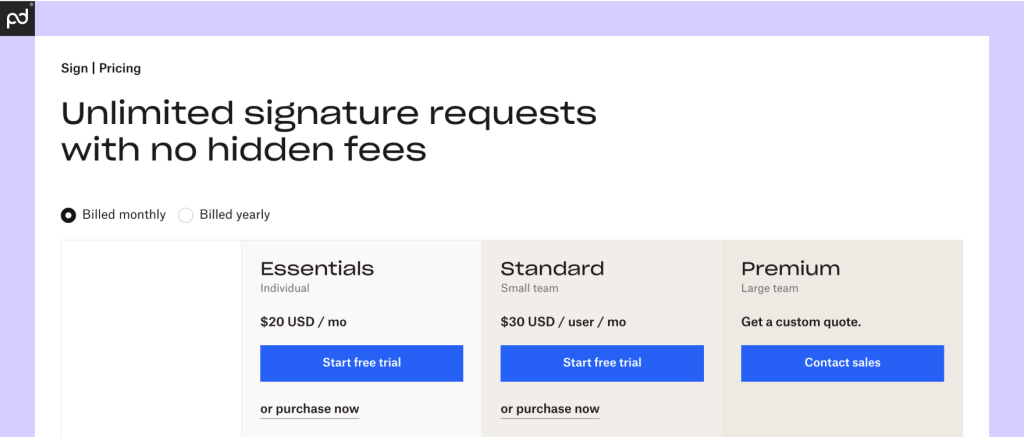
The platform still provides essential automation features, but it does so in a user-friendly way.
This approach makes it especially useful for single users and small businesses who may not require the extensive customization options found in other platforms.
Unlike Acrobat Sign, Dropbox Sign also doesn’t offer native document editing capabilities.
However, the platform offers seamless integration with Dropbox’s cloud storage, allowing users to easily access and modify documents using their preferred external editors before uploading them for signing.
Compared to DocuSign and Acrobat Sign, Dropbox Sign tends to fall short in the number of features on offer.
Users with Dropbox Sign will find most of the common e-signing features at their disposal, including branding options, in-person signing, mobile apps (iOS / Android), and signer attachments.
However, many of the more advanced features found in other e-signing solutions are absent.
In terms of transaction limitations, Dropbox Sign offers greater flexibility than its competitors — with a small caveat.
Beyond the entry-level plan, all Dropbox plans have a minimum seat count of two or more.
This means that small teams seeking higher-end features could end up paying for unnecessary seats in order to get the features that they need.
This is offset by the ability to send an unlimited number of documents, something that few providers outside of Dropbox Sign and PandaDoc provide in the modern e-signature market.
Our suggestion
The right e-signature platform for your team will largely depend on how you intend to balance workflow automation, transaction limits, and budgets.
DocuSign, Acrobat Sign, and Dropbox Sign address those issues with a combination of different features and restrictions.
- DocuSign provides the biggest toolkit for complex workflows and automation, particularly at the enterprise level.
- Acrobat Sign offers PDF editing and a balance of automation and flexibility with more comfortable transaction limits.
- Dropbox Sign removes transaction limits entirely and offers a standard toolkit for modern e-signers.
Keep in mind that PandaDoc is the best choice for a combination of all three solutions.
We offer the tools to build complex workflows, native document creation and editing, and no transaction limits.
Document preparation & editing
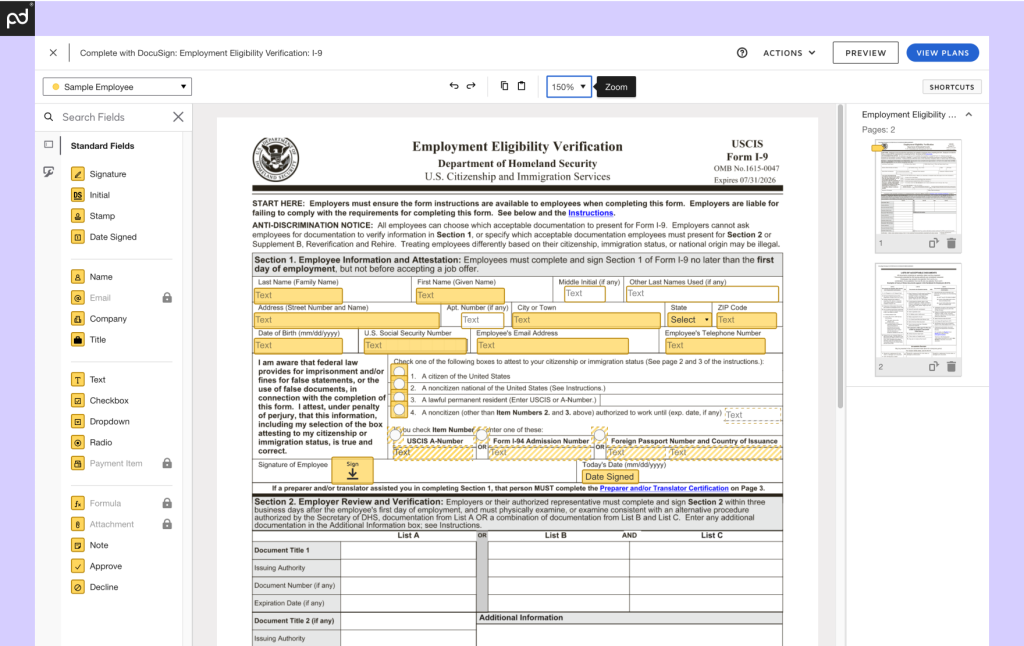
Efficient document preparation and editing capabilities are crucial for a smooth e-signature workflow, but all three platforms handle this differently.
DocuSign offers a range of document preparation tools to streamline the signing process.
Users can easily add standard fields like signatures, initials, dates, and text fields using a drag-and-drop interface.
Additionally, DocuSign allows for the creation of custom fields and tags for more specialized requirements. For repetitive tasks, templates can be created and reused, saving time and ensuring consistency.
This is much different from PandaDoc templates — part of your content library — which can still be fully customized upon creation.
While DocuSign doesn’t allow for direct document editing within the platform, it integrates with popular document editors like Microsoft Word and Google Docs (more on this below), allowing users to make changes before uploading the final version for signing.
Acrobat Sign boasts powerful document preparation and editing features.
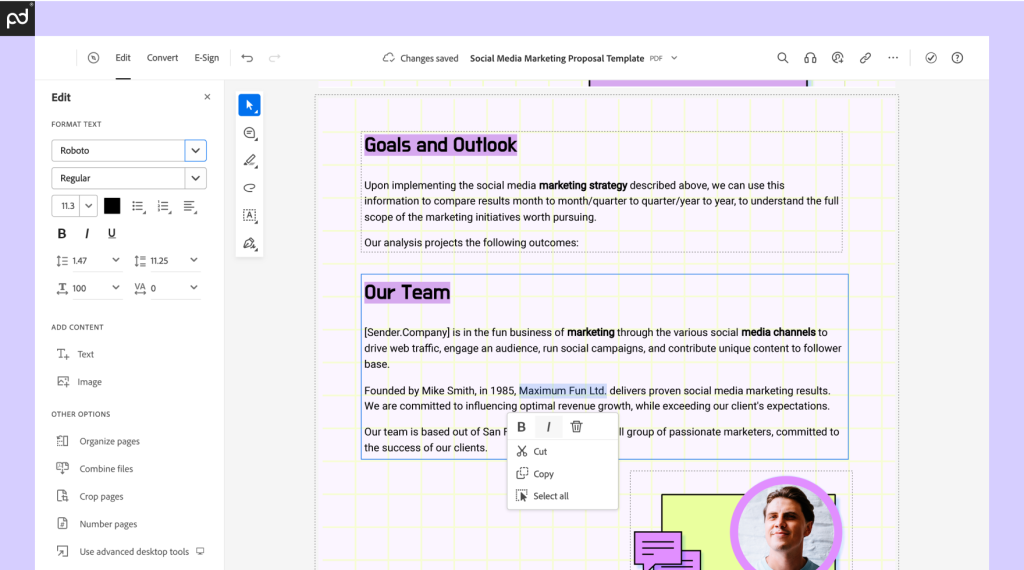
Users can directly edit PDFs within the platform, adding text, images, and annotations as needed. The drag-and-drop interface also allows for easy placement of e-signatures and other fields.
Acrobat Sign also offers advanced features like form field recognition, which automatically detects and converts form fields in PDFs, simplifying the preparation process.
Of the three contenders in our comparison, these features far exceed the capabilities found in DocuSign or Dropbox Sign.
While it’s not possible for Acrobat Sign to create documents entirely from scratch, native PDF editing adds a huge amount of flexibility to any contract lifecycle management process.
These capabilities allow users to keep all contract negotiations and required revisions inside the application, minimizing handoffs during negotiation/revision in a way that is more difficult with traditional (inflexible) e-signing platforms.
Dropbox Sign focuses on simplicity and ease of use, making it the most straightforward editing tool in our comparison.

Compared to DocuSign and Acrobat Sign, Dropbox Sign offers fewer overall features.
The platform is equipped with the basics, and users will have all the necessary tools to create legally binding electronic signatures.
However, while all of the mainstay features are present, the platform simply isn’t built to handle more advanced routines and workflows.
As with both DocuSign and Adobe Sign, users will have access to signature blocks, initials fields, and various other fields for document preparation, but the similarities end there.
Where Acrobat Sign offers onboard PDF editing and DocuSign offers increased extensibility via payment gateways and conditional logic, those features aren’t available with Dropbox Sign.
Our suggestion
Overall, the workflow surrounding document preparation is similar between the three platforms.
All competitors use drag-and-drop tools and are intended for use with PDF documents.
Even Acrobat Sign, which features onboard editing, can only offer limited flexibility due to the restricted nature of PDFs.
This is a major difference between PandaDoc and other platforms, since the PandaDoc editor supports both new document creations nd native editing for uploaded Word documents (DOCX files).
Despite these similarities, the platform you ultimately choose is most likely to be guided by your use case and desired workflow.
- Acrobat Sign adds PDF editing to its drag-and-drop interface, making it a great fit for teams who need to modify those documents.
- DocuSign provides essential document preparation tools and the flexibility to edit documents using your preferred external editors via extensions and add-ons.
- Dropbox Sign provides a streamlined e-signing experience, but it lacks many of the core features seen on competitive platforms.
Ecosystems & integrations

In most modern businesses, digital signature capture isn’t a standalone function.
It’s part of an integrated workflow that combines document generation, approval processes, contract negotiation, and other key elements of dealmaking.
To make the process truly seamless, integrations are key.
However, DocuSign, Acrobat Sign, and Dropbox Sign all tackle this functionality in very different ways, and your experience will vary depending on the ecosystem you select for your signing process.
Overall, DocuSign boasts more integrations than Acrobat Sign and Dropbox Sign combined.
The platform easily supports over 350 pre-built integrations across various categories, including CRM, productivity, cloud storage, and more.
However, keep in mind that Salesforce, Microsoft Dynamics, and NetSuite integrations are locked behind Enhanced Plans.
In addition to pre-built integrations, DocuSign offers a robust API, enabling developers to create custom integrations tailored to specific business needs.
This requires a separate API plan, but the toolkit further extends DocuSign’s reach and enables it to integrate in ways that aren’t possible with other applications.
A final consideration with DocuSign is the ecosystem itself.
DocuSign’s e-signing solution is only a small part of the DocuSign ecosystem.
At the enterprise level, separate solutions around contract lifecycle management and document generation are also available, further expanding DocuSign’s footprint with an organization.
Acrobat Sign offers far fewer native integrations with third-party products when compared to DocuSign — although their library is still quite extensive. (We counted 70+ integrations in total across all categories.)
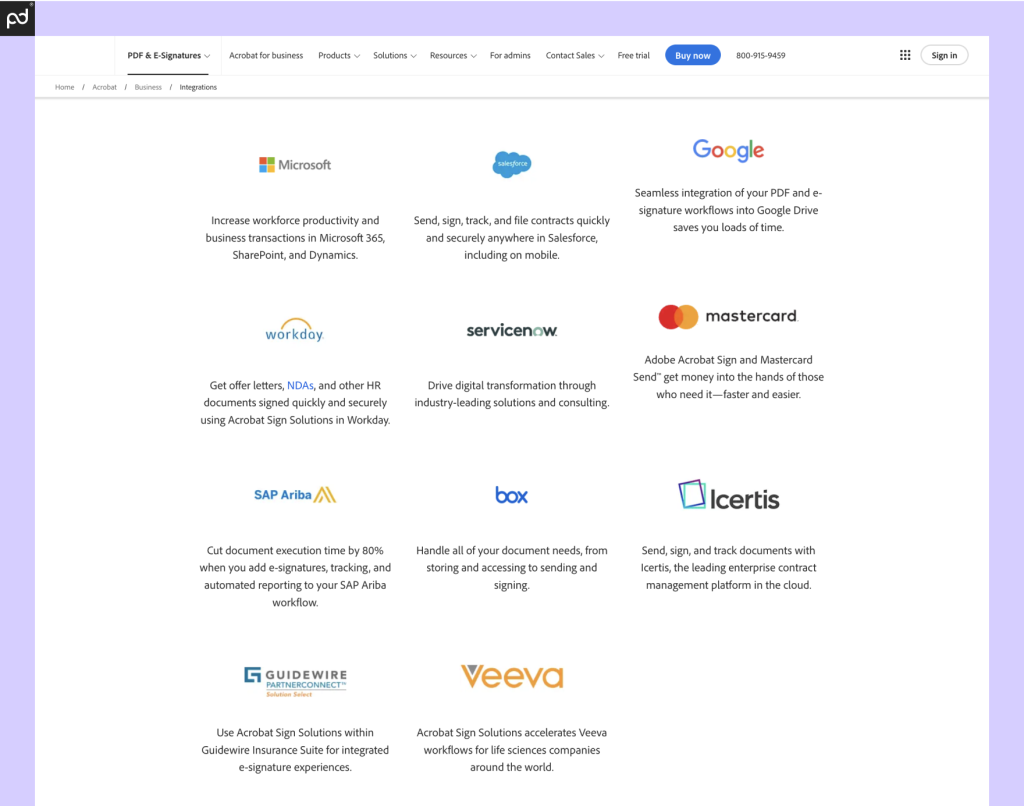
The platform’s native integration with Acrobat Reader (included in your e-signing subscription) allows for PDF editing.
However, the workflow is so closely integrated that using Reader almost feels like using Acrobat Sign.
Adobe also offers a solution tied very closely to Microsoft 365.
The integration is similar in many ways to our own Microsoft integration, which allows users to connect directly to Microsoft Word for fast and easy in-app document preparation.
Adobe’s Microsoft solutions are available on all plans, making it possible to use them without incurring additional costs.
Internally, Acrobat Sign doesn’t offer users much in the way of extensibility.
While it’s possible to purchase additional Adobe products, most are tucked away inside the Creative Cloud Suite, which doesn’t integrate with Adobe Sign or the company’s document technology at all.
Even Adobe Document Cloud, available for an additional fee, stands apart from its Creative Cloud as a place for uploaded and signed PDF files.
All that said, while Acrobat Sign’s integration library may not be as extensive as DocuSign’s, the platform is focused on providing seamless connectivity with tools commonly used for document-centric processes.
Dropbox Sign offers the fewest number of integrations but provides enhanced integration with the Dropbox storage and file sharing platform.

The Dropbox integration allows users to easily access, sign, and manage documents stored in Dropbox, it’s also the most comprehensive integration that Dropbox Sign provides.
The key benefit for Dropbox users is that Dropbox Sign can be accessed through the right-click menu, rather than users being forced to upload files via an upload module or a drag-and-drop window.
While this is ideal for Dropbox users, other platforms like DocuSign, Acrobat Sign, and PandaDoc can connect to and receive files from Dropbox as well.
Users will also find that the platform offers connectivity to Google Drive, Gmail, and other potential storage and productivity tools.
However, these connectivity options are limited in both capacity and scope.
Where CRMs are concerned, Dropbox Sign is outclassed by Acrobat Sign and DocuSign.
The platform offers connectivity with Salesforce, HubSpot, Microsoft Dynamics, and a few other platforms, but other connectors will require a Zapier connection.
Our suggestion
We know that connectivity is important, especially to teams who want to create a smooth, streamlined workflow that “just works” with other elements inside the tech stack.
It’s one of the reasons that PandaDoc provides 30+ native integrations with popular tools like payment gateways, CRM platforms, and more.
All things considered, teams will need to strike a balance between platform functionality — that is: what the platform is capable of handling — and how the platform connects with other software in the business lineup.
- DocuSign is the clear winner here, simply in terms of the number of connectors and integrability of other DocuSign products for enterprise teams.
- Acrobat Sign offers fewer integrations compared to DocuSign, but it offers more by way of PDF editing and overall involvement in the user workflow.
- Dropbox Sign is very limited in scope, but it integrates natively with Dropbox and can dramatically speed up processes for Dropbox users.
Customer support options
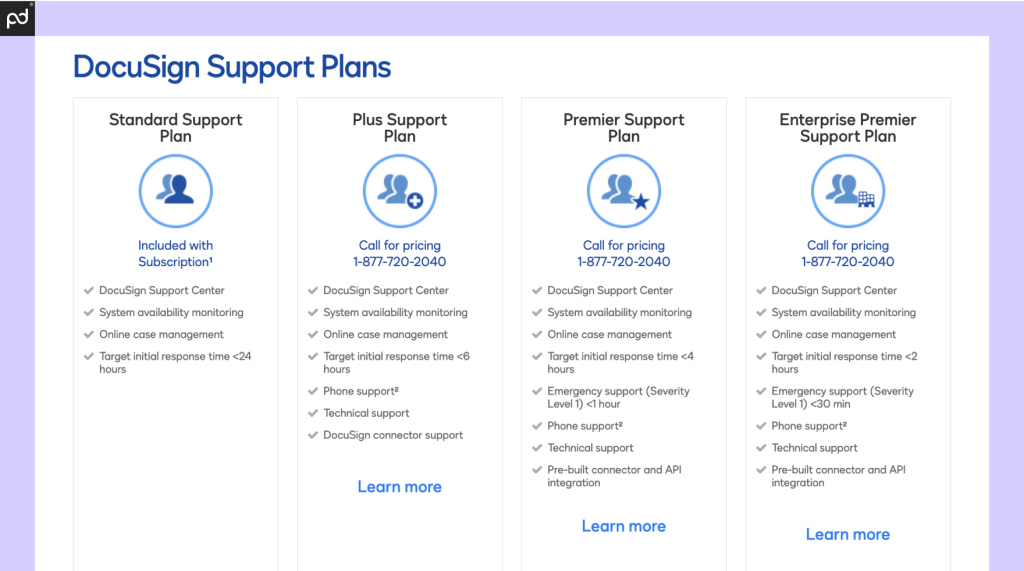
When choosing an e-signature solution, the level of support available can be a crucial factor, particularly for businesses that rely heavily on these tools for their daily operations.
DocuSign offers a range of premium support options tailored to the needs of businesses of all sizes, but the quality and turnaround time will vary depending on which plan you select.
Generally, faster response times require more robust support options where DocuSign is concerned.
At the Premier and Enterprise Premier levels, it’s possible to get in touch with a DocuSign rep in relatively short order.
Enhanced Plans even feature 24/7 live support (similar to what PandaDoc offers by default).
Teams on higher-end plans also receive support from a dedicated account manager who can proactively monitor usage, offer personalized guidance, and help optimize the platform to achieve business goals.
The only issue is cost.
All of DocuSign’s support plans are priced separately from their products.
Ultimately, it’s up to the team to decide what support options work best for them and how quickly they’ll need a response if anything goes wrong.
Acrobat Sign offers premium support options focused on providing expert guidance and timely resolutions.
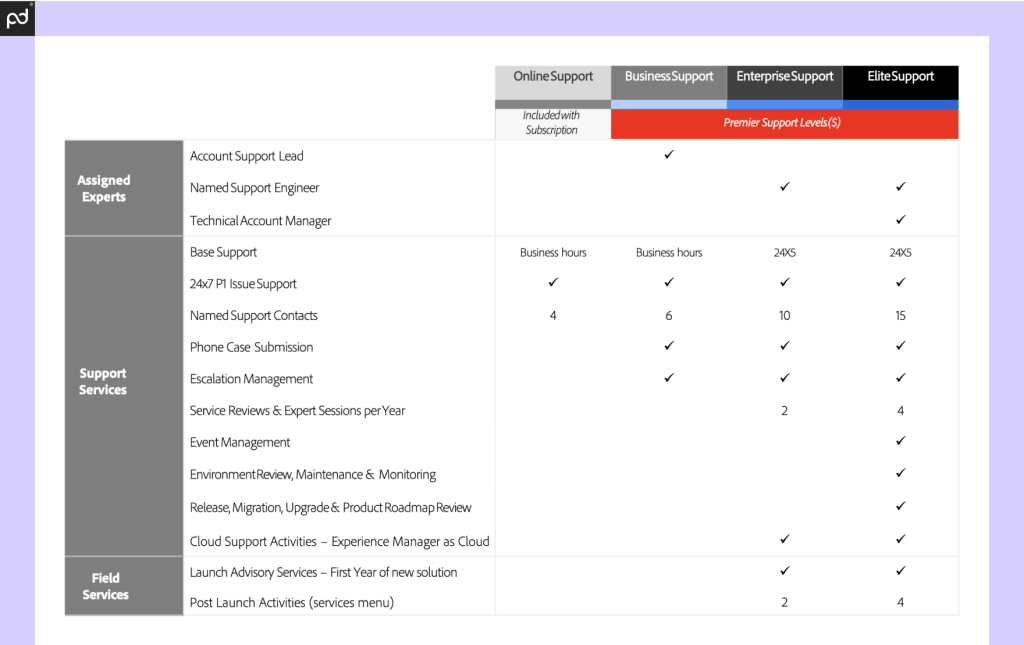
Similar to DocuSign, Adobe offers a multi-tiered support solution with a host of additional features available at higher levels.
One key difference when compared to DocuSign is that all Acrobat Sign plans offer 24×7 chat/phone support for critical issues (P1 issues).
This makes it much easier to resolve critical issues, regardless of plan.
Outside of that, service levels drop precipitously.
Standard support can take up to three days to reply for minor issues, but major issues impacting mission-critical workflows may receive a response in as little as four hours.
This window tightens considerably on updated plans, but users won’t ever see true 24×7 chat support outside of PI issue support.
Higher end plans also offer additional named support contacts, engineers, and technical account managers.
The latter is exclusive to Elite Support options but has the ability to pull in support across multiple teams to drastically improve the Acrobat Sign experience.
Advanced plans also receive other perks, including additional training and support, case reviews and service metrics, and even a preview into Acrobat Sign’s production roadmap.
Dropbox Sign’s support options aren’t as extensive as DocuSign or Acrobat Sign.

The platform only offers two levels of paid support as separate add-ons, and the service largely scales by adding a greater selection of outreach and contact options.
The standard support plan offers email outreach with a targeted response time of one business day. At the next level, users have access to 24/7 live chat support and phone support during local business hours (where supported).
Email response times also increase. The highest tier gives 24/7 phone and chat support, as well as further-improved email responses.
Overall, the entitlements offered through Dropbox Sign are far more simplified than those available on other platforms.
In some ways, Dropbox Sign’s limited structure is an advantage for smaller teams, who may not want to pay extra for additional features that they never intend to use.
Upgrading to Level 1 provides access and accelerates response times without adding a multitude of additional perks.
At the same time, enterprise teams may find the lack of a dedicated account manager or technical specialist frustrating if specialized or cross-departmental support is required.
With Dropbox Sign, those features simply aren’t an option.
Our suggestion
When it comes to support solutions, there isn’t a one-size-fits-all answer.
Most standard support plans provide self-service options and limit contact with company representatives.
In fact, PandaDoc is one of the only platforms that provides human-powered, live chat support for all users, regardless of plan.
Add-on packages and upgraded support plans will incur additional costs that are entirely separate from your product plan.
If e-signing is a mission critical process, and you need to maximize uptime or resolve issues quickly, be sure to factor these solutions into your decision-making process.
- DocuSign offers the most extensive support solution, with multiple plan tiers and varying levels of support.
- Acrobat Sign features some unique support features, including multiple named engineers and points of contact.
- Dropbox Sign support plans offer improved access and different ways to communicate with the sales team but provide little beyond that.
- PandaDoc provides 24×7 chat support to all users by default and offers a premium support plan for users who want extra perks.
Alternatives to Dropbox Sign, Acrobat Sign & DocuSign
While Dropbox Sign, Acrobat Sign, and DocuSign are undoubtedly industry leaders, the world of e-signatures is vast and diverse.
If you’re seeking alternatives that might better suit your specific needs or budget, several other compelling options are worth exploring.
Here’s a quick list:
Remember: The best e-signature solution depends entirely on your unique requirements and preferences.
Take the time to explore different options, compare features, and consider free trials before making your final decision.
The perfect e-signature tool is out there waiting to streamline your document workflows and elevate your business to new heights!
Want even better documents?

While DocuSign, Acrobat Sign, and Dropbox Sign are prominent players in the e-signature market, other solutions cater to different needs.
If you’re looking for an alternative that combines ease of use with advanced document creation and management capabilities, PandaDoc is a strong contender.
PandaDoc stands out with its intuitive interface, robust document editor, and built-in CRM features.
It’s a versatile platform that simplifies not just e-signatures but the entire document lifecycle, from creation to tracking and analytics.
Some notable PandaDoc features include:
- Drag-and-drop document editor. Empowering you to effortlessly customize documents with a simple, visual interface.
- Content library. A centralized repository for storing and reusing frequently used content blocks, ensuring consistency and efficiency.
- Conditional fields. The ability to create dynamic documents that adapt based on user input or other criteria, streamlining the signing process.
- Payment integration. Seamlessly collect payments directly within documents, simplifying transactions and improving cash flow.
- CRM integration. Effortless data syncing and workflow automation with your existing CRM system, eliminating manual data entry and enhancing productivity.
If you value a user-friendly experience, document customization, and the ability to manage your entire document workflow in one place, PandaDoc could be the perfect fit for your business.
Sign up for a free 14-day trial or request a personalized demo and get a firsthand look at how PandaDoc can change the way your organization handles critical business documents.
Disclaimer
Parties other than PandaDoc may provide products, services, recommendations, or views on PandaDoc’s site (“Third Party Materials”). PandaDoc is not responsible for examining or evaluating such Third Party Materials and does not provide any warranties relating to the Third Party Materials. Links to such Third Party Materials are for your convenience and do not constitute an endorsement of such Third Party Materials.
Originally published March 15, 2022, updated September 16, 2024


